Kingsnakes are widespread species that are well-adapted to a variety of habitats, even extending to urban and suburban neighborhoods. This is why they may be a threat to the safety of children and pets if they ever think of visiting your home.
So, how to get rid of kingsnakes? You can do so by using dry and damp cloths, sweeping them into a large enough container using a sturdy broom, and installing glue boards on walls or other escape routes.
This comprehensive guide will help you with everything you need to know about kingsnakes, how to properly identify them, and how to prevent them from ever coming back. Read for more!
What Are Kingsnakes?
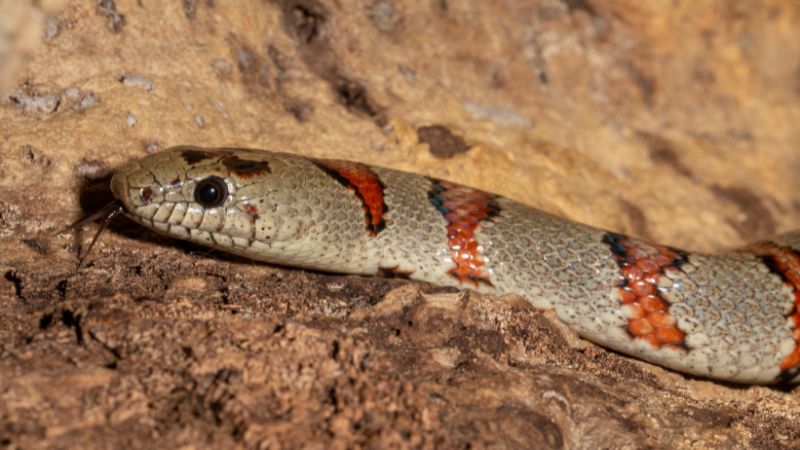
Kingsnakes refer to a group of nonvenomous snakes in the Lampropeltis genus containing 26 known species. They are popularly known for their vibrant scales but in reality, they come in a variety of colors, markings, and patterns.
These snakes are often mistaken as coral snakes due to their coloration and pattern. All kingsnakes have stable breeding populations, which is why they are classified as a species of least concern.
What Do Kingsnakes Like?
Kingsnakes love to sun themselves, especially during the cold days of the fall and spring seasons. They also like spending their day hiding under vegetation and other debris. About 21% of their time is spent hunting and traveling.
What Do Kingsnakes Eat?
It depends on the species but most of them primarily consume other snakes (even venomous ones!), white-footed mice, five-lined skinks, quail eggs, lizards, and meadow voles.
Where Do Kingsnakes Live?
They occupy various regions in North America and are found in deserts, forests, grasslands, and urban areas. Some coastal species prefer being found near water sources while others are restricted to dry habitats.
How Long Does Kingsnakes Live?
Their lifespan in the wild is not well-recorded. However, they are speculated to live 9 to 15 years old. They live much longer in captivity, reaching up to 33 years under the proper care and maintenance.
How Big Will Kingsnakes Get?
Kingsnakes can reach a length of up to 5 feet and a weight of up to 5 pounds. However, size varies greatly per species. Male and female snakes have don’t have a big discrepancy in terms of size.
What Is the Behavior of Kingsnakes?
Generally, kingsnakes are diurnal and are active from late March to early November. During the winter season, they hibernate in rock crevices, caves, and hollow logs. They spend a lot of time hiding under vegetation and debris.
Types of Kingsnakes
Common Kingsnake
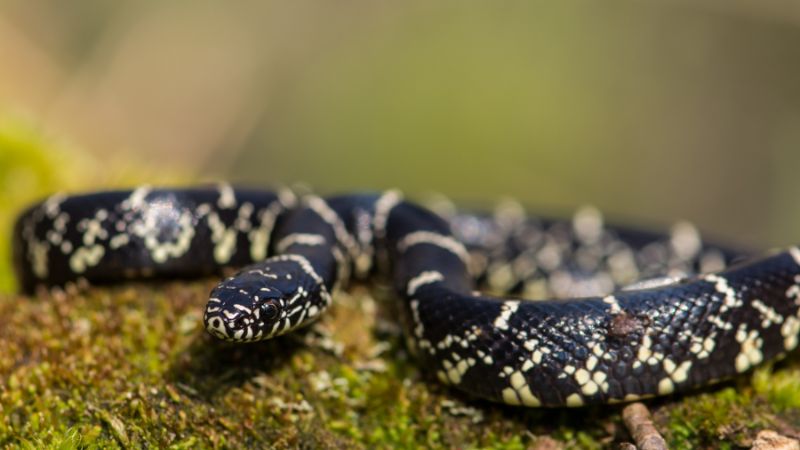
Common kingsnakes, also referred to as Eastern kingsnakes, are the most widespread kingsnake species across North America. There are currently seven subspecies identified by their native range. They are usually spotted out and about during the summer.
- Scientific Name: Lampropeltis getula
- Appearance: Generally, they are glossy black with yellow or white crossbar patterns that resemble chains. Coloration and pattern may vary by geography.
- Habitat: Forests, swamps, bottomlands, tidal wetlands, hammocks, farmlands, and suburban areas
- Geographic Range: Eastern United States
- Size: Up to 5 feet (length); Up to 5 pounds (weight)
- Characteristics: Diurnal, solitary, excellent swimmers and tree climbers, and aggressive during mating season.
California Kingsnake
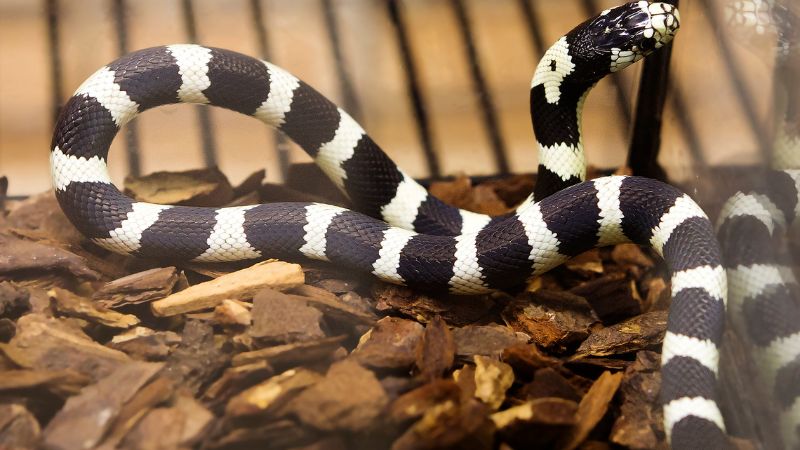
California kingsnakes are subspecies of the common kingsnake and are known to efficiently disguise themselves against predators due to their striped and banded patterns. They can become domesticated to eat raw meat and chicken.
- Scientific Name: Lampropeltis getula californiae
- Appearance: Shiny black with white body markings and yellow or white crisscross patterns. However, they can also be striped, ringed, or spotted.
- Habitat: Grasslands, marshes, deserts, forests, and scrubs.
- Size: Up to 5 feet (length); Up to 4 pounds (weight)
- Place of Origin: Southwestern and Baja California
- Characteristics: Primarily diurnal but will turn nocturnal during hot weather. It is also solitary except during hibernation.
Scarlet Kingsnake
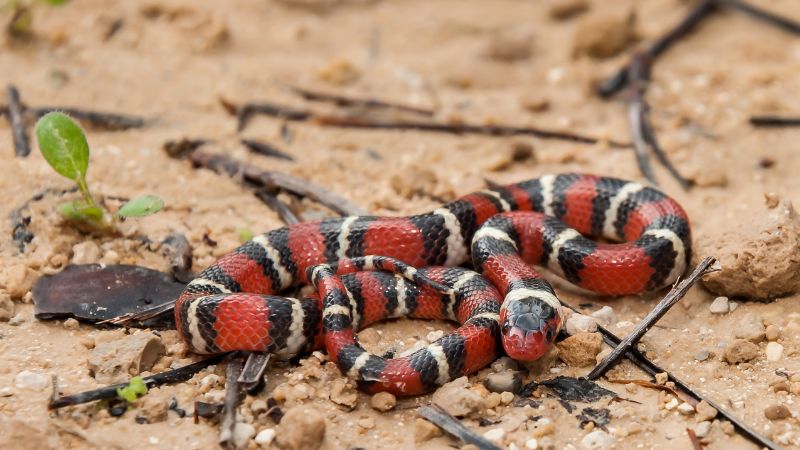
This species has arguably the most beautiful coloration and pattern in all kingsnakes. They look similar and are often mistaken for the Eastern coral snake and Scarlet snake, which are two completely different species.
- Scientific Name: Lampropeltis triangulum elapsoides
- Appearance: Alternating bands of black, red, and yellow that extends across its belly.
- Habitat: Prefers well-drained sandy habitats and pine forests
- Size: Up to 20 inches (length); Up to 3 pounds (weight)
- Place of Origin: Eastern and Southeastern United States
- Characteristics: Primarily nocturnal, solitary, and are excellent climbers.
Why Do They Call Them Kingsnakes?
They are referred to as “king” snakes because they eat other snakes, even venomous species such as rattlesnakes. Interestingly, venom toxins don’t do anything fatal to kingsnakes unless they are bitten many times.
Related: How to Get Rid of Black Rat Snakes? | Effective, Safe, and Humane Solutions
What’s the Largest Kingsnakes?
Conservation workers in Southern California an “astonishingly” huge 7-foot California kingsnake in 2022. This species rarely exceed 4 feet which is why the conservationists were shocked. They quickly relocated the snake before it gets trampled on by vehicles.
Are Kingsnakes Dangerous?
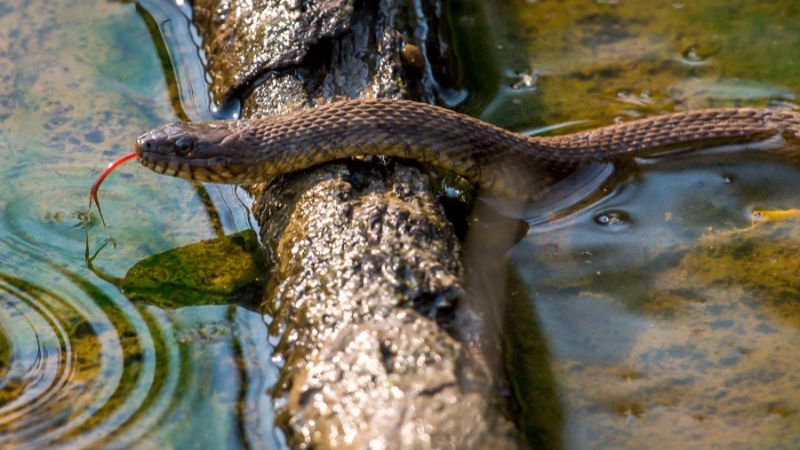
No. Like other non-venomous snakes, kingsnakes do not pose a direct threat to people, pets, and livestock. However, they will bite as a defense mechanism when they feel threatened or are intentionally bothered.
Additionally, kingsnakes are actually quite helpful and efficient in getting rid of venomous snakes. They are good to have around but if you have children and pets, it’s best to get rid of them instead before they unknowingly bite them.
Related: How to Get Rid of Timber Rattlesnakes | Effective Methods to Ensure Safety
Why Are Kingsnakes Attracted to Your House?
If your house or surrounding vicinity has enough food sources to support kingsnakes, that’s probably why they barged into your territory. Moreover, they may be looking for shelter against predators or harsh weather conditions.
Signs of Kingsnakes
- Sightings of the snakes themselves
- Fecal droppings
- Eggs found in rotting logs or under debris
- Shed snake skin
- Slither tracks or winding trails
- Hissing noises or uncommon noises coming from inside or outside your home
Related: How to Identify Snake Droppings? | Identification and Guide
How to Get Rid of Kingsnakes?
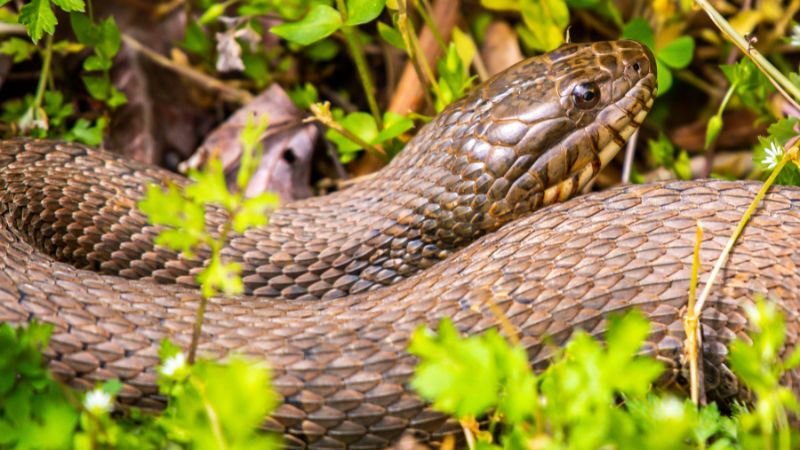
If you encounter a kingsnake in your lawn, it’s best to leave them alone as they will go away on their own. However, if you want to remove them to avoid future problems, here are strategies that can help you:
- Using cloths: Place a dry cloth on top of rumpled, damp cloths in areas where you think you’ve last seen the snake. Once they’re attracted to the spot and effectively caught, release the snake someplace far.
- Sweep into a container: Using a sturdy broom, sweep the kingsnake into a large garbage can, bucket, or other appropriate containers that are large enough to accommodate the size of the snake.
- Install glue boards: Place these against a wall or on other places where the snakes could use as an escape route. If the snake is big, attach several glue boards on a piece of plywood. Pour vegetable oil onto the glue to remove the snake.
Related: How to Get Rid of Garter Snakes | Effective Techniques for a Snake-Free Home
How to Prevent Kingsnakes From Getting Into Your House?
Preventing future kingsnake infestations is key to keeping your home safe and sound. Follow the tips below to keep snakes from ever entering your house and property ever again:
- Seal all cracks and openings that are a quarter inch or larger. The sealing material to be used depends on which part of the house are you planning to plug:
- Mortar: For holes in concrete block, poured concrete, or brick foundations.
- Sheet metal or hardware cloth: For cracks and holes in wooden buildings.
- Injectable foam or caulk: For openings in doors, windows, electrical pipes, and plumbing pipes.
- Galvanized screening: For drains and vents.
- Construct snake-proof fences. Although it’s costly, you can choose to fence just a small area where children and pets can safely play. Use 1/4-inch hardware cloth that is at least 36 inches wide then bury it 6 inches into the ground.
Related: How to Get Rid of Northern Water Snakes | Best Solutions and Preventative Measures
List of Sources
Andrews, K., & Willson, J. D. (n.d.). Eastern Kingsnake (Lampropeltis getula).
Bartz, S. (n.d.). Lampropeltis getula: Common Kingsnake.
Cal Poly Land. (n.d.). California Kingsnake.
Florida Museum. (n.d.). Eastern Kingsnake.
Florida Museum. (n.d.). Scarlet Kingsnake.
Idaho Falls. (n.d.). California King Snake.
Knight, J. E. (n.d.). Coping With Snakes in Montana.
Maryland Zoo. (n.d.). California Kingsnake.
Old Dominion University. (n.d.). California Kingsnake.
Owen, S. (n.d.). Avoiding Snake Encounters.
- How to Get Rid of Turtles | Proven Long-Term Solutions! - August 26, 2023
- How to Get Rid of Kingsnakes | Easy & Humane! - August 26, 2023
- How to Get Rid of Northern Water Snakes | Best Solutions and Preventative Measures! - August 19, 2023

